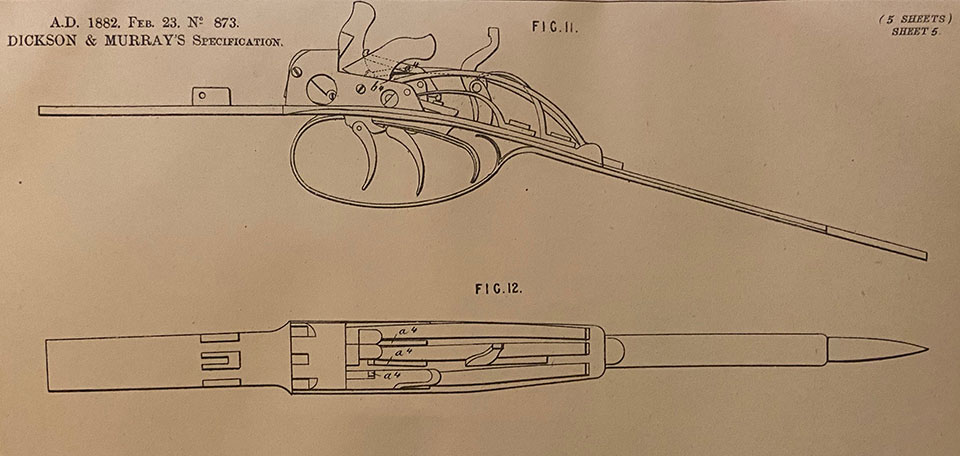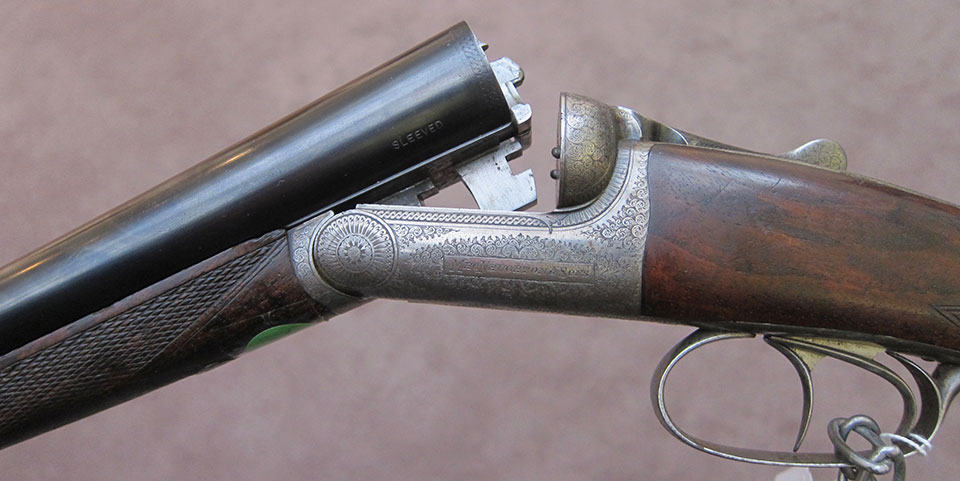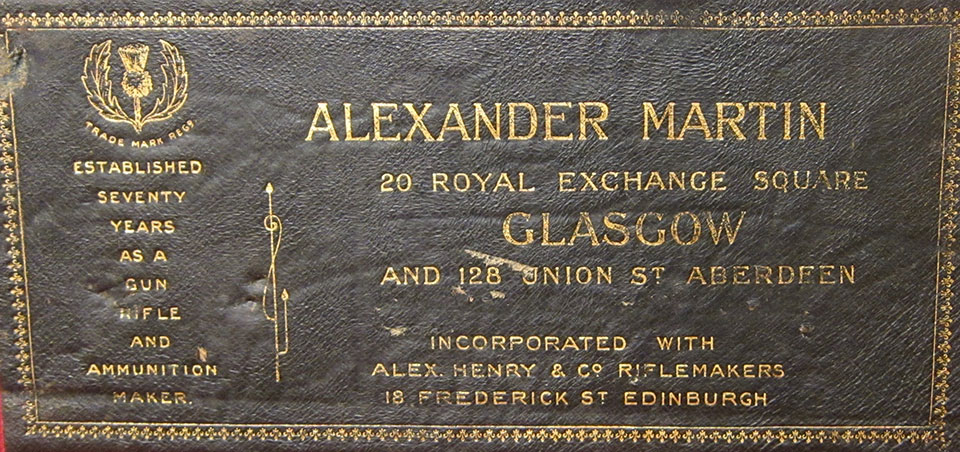The Dickson round-action quickly established itself as a superb grouse gun and Dickson’s ledgers show that the clientele was predominantly Scottish. Amongst the local nobility commissioning new round-actions, one customer stood out for his eccentricity and his backward-looking tastes.
Charles Gordon inherited a great fortune at a young age and bankrupted himself, largely by commissioning a, bizarrely wonderful, collection of over two hundred guns from Dickson, between 1868 and 1906. Sadly, his entire estate was auctioned off in his lifetime, for ‘pennies on the pound’, to pay his debts and he lived out the rest of his life in relative impoverishment.
Dickson’s fortunes, conversely, rose considerably during the first quarter of the new century. Order books were healthy and his reputation cemented. The years leading up to the First World War were happy ones, with deliveries of round-actions numbering around fifty a year. At £120 each, that represented turnover of six thousand pounds per annum, an equivalent today of £800,000, on round-actions alone.
The End of the Glory Days
Demand for guns slowed in the 1920s but times were still comfortable and the firm did steady business until the third successive John Dickson, who had no male heir, sold-up to a friend, Alexander Prain, and retired. The company continued under Prain’s ownership until 1936, when it became a limited company.
The thirties saw severe reductions in the fortunes of many firms and Dickson’s was no exception. Gunmakers were laid-off or reduced to part-time hours and sales slumped. The depression resulted in acquisitions, by Dickson, of many of Scotland’s smaller concerns. By 1938, Mortimer & Son and Joseph Harkom had been absorbed and, in 1947, Dickson’s, now trading from Frederick Street, also took on the business of James MacNaughton. However, these transactions were indicative of a malaise in the gun trade, rather than a sign of increasing prosperity for Dickson.

Circumstances, post-war, got much worse. The second-hand market was awash with sporting guns of fantastic quality, which had seen little use. Cash-strapped war widows selling their husbands’ guns created a glut. The Empire was shrinking and the country stifled by austerity. Sporting estates were being broken-up by death duties and there were few incentives to buy new guns.
As business declined, the round-action went out of production and did not re-appear until the late 1980s, when a Dutch firm offered to employ, then novel, CNC machinery to build guns more cost-effectively. It wasn’t a success; the project was abandoned after a couple of guns, as it quickly became apparent that the technology was not mature enough to make a round-action of the quality required.
For the next decade, the famous old gunmaker was reduced to the status of clothing outlet, with guns and gun-making very much in the background.
An Investor Calls
In 1999, an American investor took control and provided the necessary money to re-style the business at 21 Frederick Street as ‘Dickson & MacNaughton’. Workshops were installed at Dunkeld in 2001. In 2003, another wealthy benefactor took the reins; a Dickson enthusiast and businessmen, from the United States, called Bob Palmer.
During Bob Palmer’s tenure, some notable guns were made, including one with a portrait of the first John Dickson, engraved by Peter Cusack. Unlike many attempts at portraying humans on sporting guns, the gun in question is superb; Cusack capturing the essence of the man beautifully.
An Italian-originated over & under was developed in 2009 but only five guns were built. For the next decade business was muted and Dickson & MacNaughton lacked effective leadership in the UK. During these years of gentle stagnation, an enthusiast for the company and its guns had been watching and learning. His moment was about to arrive.
That man was Jean-Pierre Daeschler. ‘J-P’ began his gun-making career in Scotland and, for thirty years, had coveted Dickson. He took the time to study the company history, compile data and records of guns built, paid attention to activity at the workshop and made sure he understood the firm and its guns better than anybody who worked there.

Following a visit to Dunkeld in 2017, J-P returned home, frustrated and upset at the poor state of the company. While listening to his multitude of gripes, his wife, Zoe, instead of rolling her eyes and going back to her book, challenged him. “Well why don’t you get off your arse and do something about it?”. That challenge was the start of Dickson’s new beginning.
J-P approached the owners to enquire after any plans to revive the business. They say timing is everything, and so it proved. Bob Palmer was in declining health and his affairs were being administered by his daughter. Part of her portfolio rationalisation included divesting the family holdings of Dickson & MacNaughton.
Keeping secrets in the gun trade is impossible and vultures began to circle, in the shape of investors keen to acquire rights and asset-strip the group of companies. Visions arose of cheap foreign guns bearing the Dickson or MacNaughton names but Bob Palmer would not countenance it. He was insistent that the company be kept whole and that gun-making in Scotland remained the core business.
the company was bought and paid for from personal funds and is fully independent
Bob Palmer’s hopes and J-P Daeschler’s ambitions for Dickson were one and the same. As a Scottish-trained, practical gunmaker, J-P had the face-validity to carry off the project and the pair agreed to a full Daeschler buy-out, despite aggressive bids from other parties. Contract negotiations took a year and were completed in late 2018, making Jean-Pierre Daeschler the sole proprietor of the great Scottish gunmaker he had long admired.
To be clear, J-P is not heading a consortium of investors, nor does he have any shareholders to please; the company was bought and paid for from personal funds and is fully independent. John Dickson & Son is, once again, a gunmaker, owned by a gunmaker, making guns of its own design, in Scotland, in the traditional manner. Along with Dickson, came the rights to trade as James MacNaughton & Sons, Daniel Fraser, Alexander Henry, Alex Martin and T.W Mortimer.
Twenty First Century Dickson
The future for John Dickson & Sons is planned as a revival of their past successes. The core product, the round-action shotgun, is fabulous and the company is now in a position to make it cost-effectively and re-launch it into a market hungry for tradition and excellence.
The round-action lends itself very well to CNC and spark-erosion parts manufacture, leaving enough ‘over-size’ margin to allow Dickson’s gun-makers to apply the finish and fit at the bench.
The post-war decline of the British gun trade can be largely attributed to inflation-busting price increases and the high cost of bench-work. The gunmakers of Eibar and Brescia adapted faster and better. British gunmakers simply could not compete with the Italians and Spanish on price.
Technological strides, made over the past decade, have created an arena in which smaller, quality-driven, gunmakers in Britain can again compete. J-P Daeschler thinks we could be on the brink of another Golden Age of British gun-making and he aims to have Dickson in the vanguard.
There are currently several round-actions in production but the first major project sees traditional Dickson style meeting modern demand. The fashion these days is for small-bore shotguns. The trend began with American quail shooters, but quickly spread. The historical shortage of best-quality, adult-size small-bores has led to many customers ordering new ones from our premier gunmakers.
The 28-bore, which was a rarity in pre-war Britain, is achingly fashionable now and Dickson will be launching a new model this year to meet that demand. The gun will be a round action, with a side-lever, rather than a top-lever.
The side-lever allows for even greater strength in the action, obviating the need to machine a hole for a spindle. It also leaves the top-strap clear and provides an elegant top profile, with more area for engraving. In the past, Dickson made a number of these guns but has never before made a 28-bore side-lever.
the new round-action will be under £60,000, including VAT.
The cost of the new round-action will be under £60,000, including VAT. How does that compare with the competition? Quite well, as it happens. In 1935, the Dickson round-action and the Holland & Holland ‘Royal’ commanded the same price. In 2019, the Holland & Holland stands at around £120,000; double that of the Dickson. The two models are exactly the same today, as they were then.
The Dickson offers a real alternative to more traditional side-locks and boxlocks. Many shooting men swear by their handling characteristics and claim them to be the most rewarding guns in the world to take afield.
Personally, I find it hard to argue. The memory of a day in the pigeon hide with a newly-restored round-action 12-bore, that I took for testing before sending to its new owner in the United States, lives with me still.

I truly felt I couldn’t miss. The gun was so easy to move onto line and so reactive to those jinking, dropping, accelerating birds, as they swopped in and flared-away from the decoys on a blustery wind. I hated to hand it back.
With the re-emergence of Dickson, the sportsman, once again, has a true, and truly difficult, choice of side-lock, boxlock or round-action. With a real gunmaker in charge of the firm and a proper plan for building it into a successful business, the map of the British gun trade has changed significantly.
Published by Vintage Guns Ltd on




